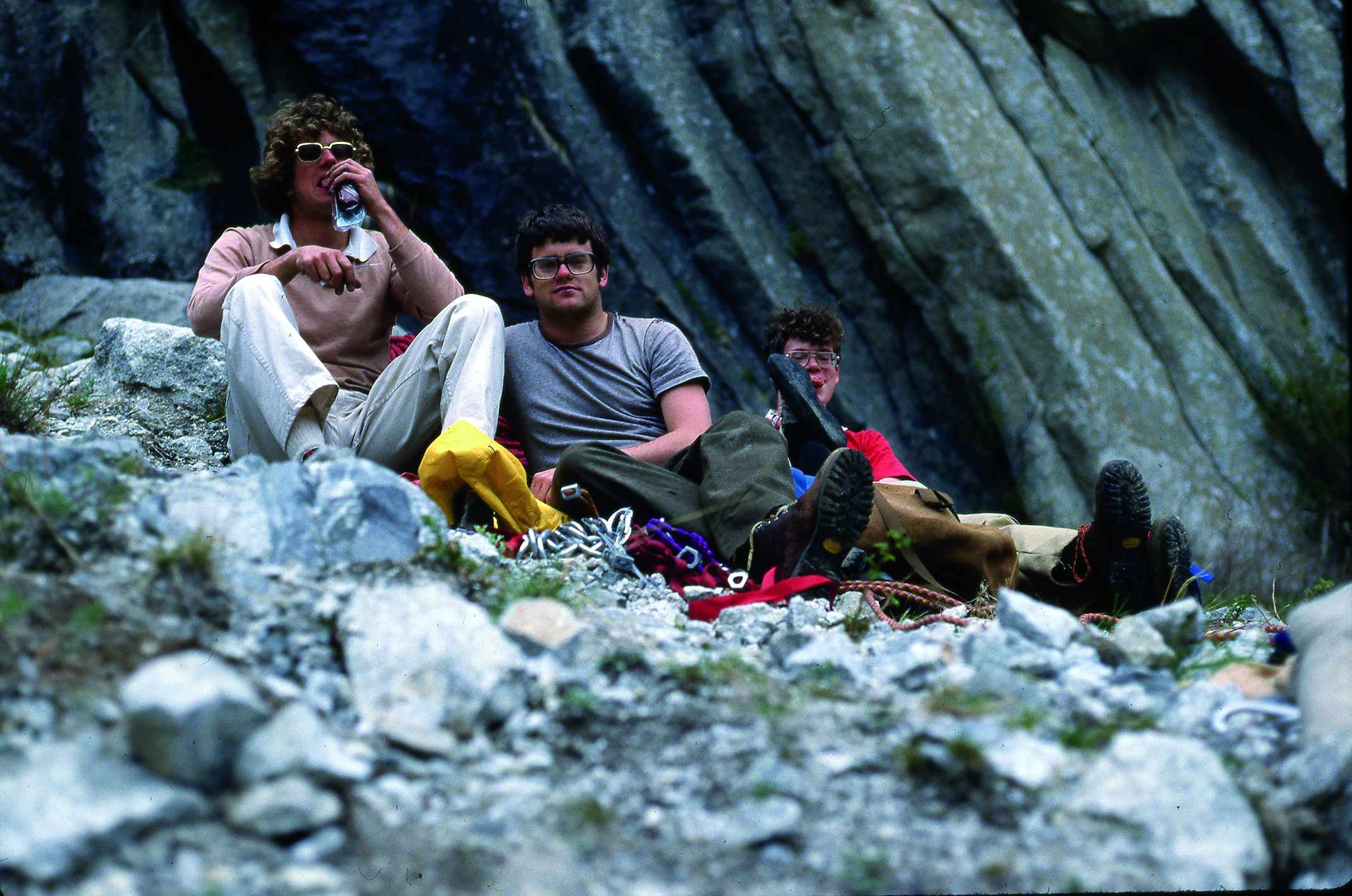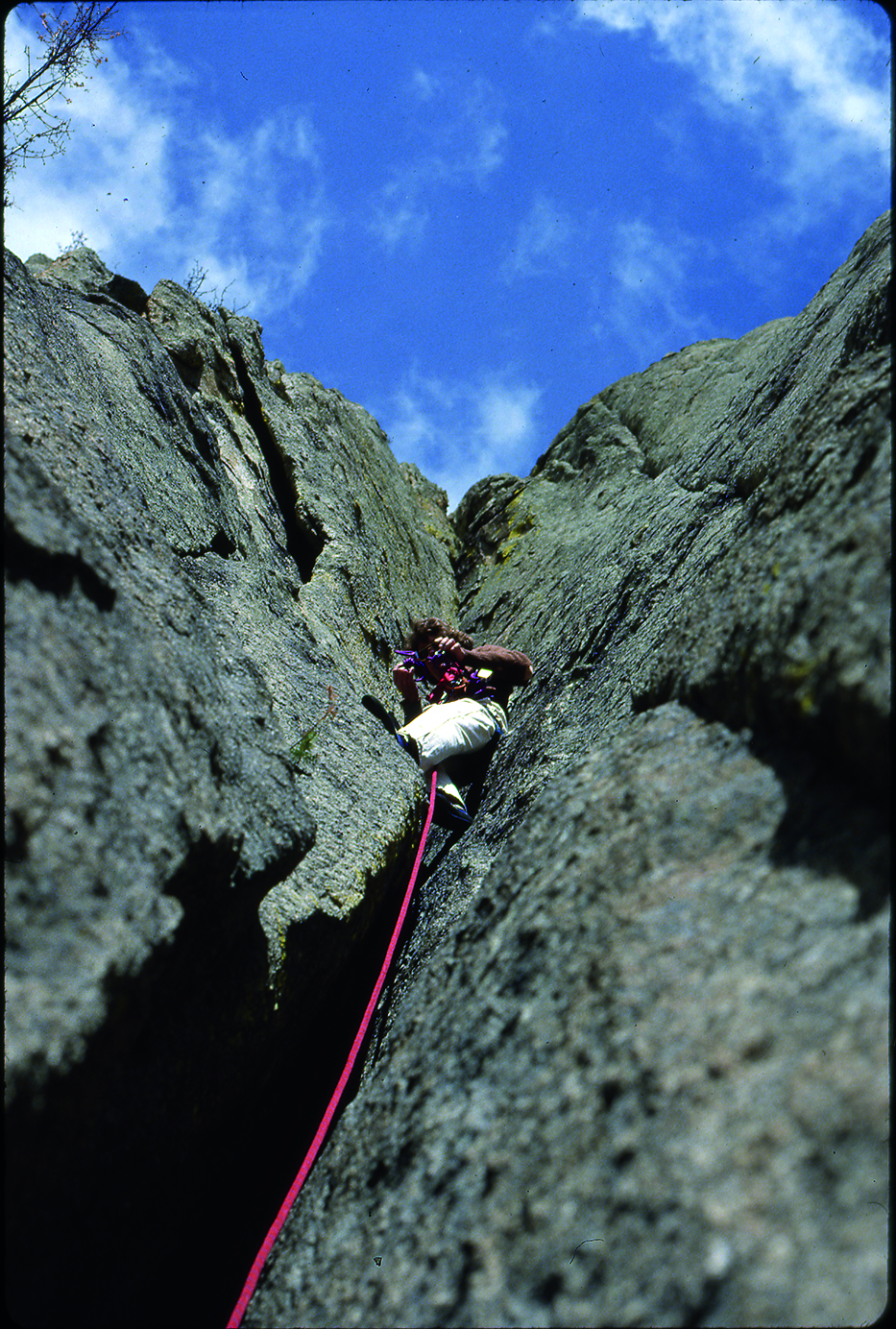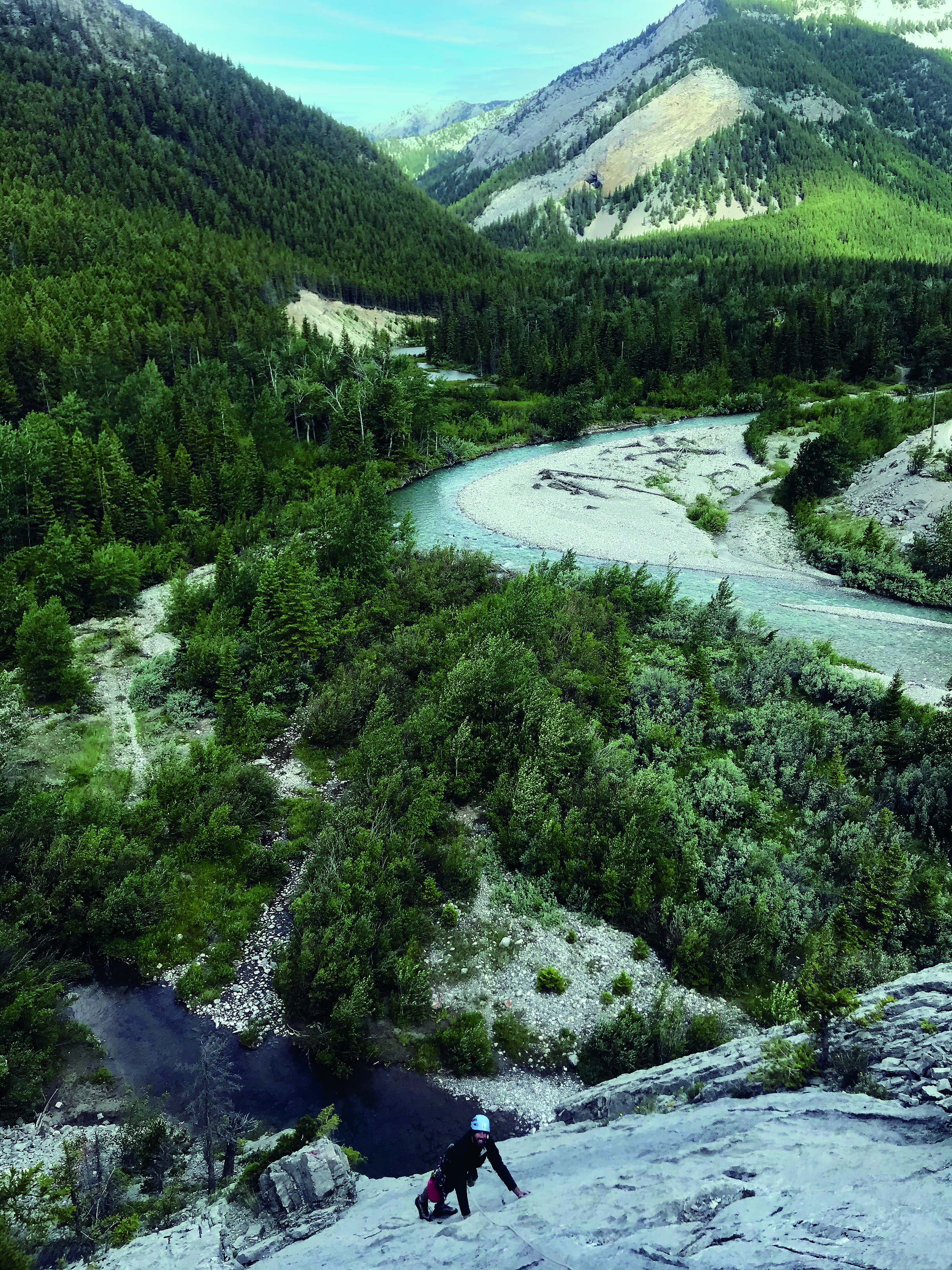Montana Climbing History with the First Ascensionists | an Interview with Bob Goodwyn
Posted by Bob Goodwyn on 5th Feb 2022

Photo: John, Chris, and Van Alke at the base of Shoshone Spire, Blodgett Canyon 1978
Bob: When did you brothers start climbing?
John: We started in 1974 & 1975, peak bagging in Glacier National Park. At this point we were climbing almost exclusively in Glacier, and didn’t start what I call technical climbing until after we took a rock and ice climbing course in the summer of ‘76. Glacier would continue to be a place of inspiration for me. We started climbing harder and harder peaks until we decided we needed more technical skills.
Chris: Yep. And in 1976 we hired some instructors from the Trailhead in Missoula.
John: That’s right. At that time Charlie Stevenson and his partner owned the store, and he had these guys working for him who would take people out.—Of the names I can remember there was Elliot Dubrueil, Dexter Hale, Don Scharfe, Todd Onken, and Randy Winner.
Two of these guys would become notable in the history of Montana climbing. Dexter Hale was one of the most prolific ice climbers and the originator of Big Horn Mountain Sports in Great Falls, MT. Don Scharfe was an accomplished climber and adventurer as well, and would open Rocky Mountain Outfitters in Kalispell, MT.
Bob: At this point, were you all still living at home? What did your parents think of your climbing?
John: We were out of high school, but we grew up on the base of Mt. Helena, over on Hauser Boulevard. Our dad was in the 10th Mountain Division. He had books all over the house about mountaineering, climbing, even books focused on Mt. Everest ascents. We drew our inspiration and some of our technical knowledge just from reading. We’d be on our way out of the house, headed up the hill towards Mt. Helena, and Mom and Dad would say, “Just don’t play on the cliffs!” And of course, that’s right where we were headed.
Bob: Dang, there are kids still doing that today I hope, getting their start on Mt. Helena.
John: To be clear, we didn’t transition from playing on the cliffs of Mt. Helena to real climbing. At least in my case, we played on the cliffs when we were little kids, 4th grade probably through Junior High. All three brothers did team sports in highschool like cross country, track, and ski team. When we climbed Chief Mountain in Glacier Park in 1974, it was probably the first real mountain we had ever climbed. I was 23, Chris was 26, Van was 16. In other words, Chris and I started really late.
Chris: Yea, at that point it was the late 70s early 80s, I was working as a carpenter. And I was on such a tight budget that I’d save every dang receipt for every piece of climbing gear we ever bought. I still have a stack of old yellow receipts, most of them from the Basecamp. I figured at one point I should’ve just bought stock in some of those climbing companies. I was well known at the Basecamp, and Scott Brown hired me to do some of their remodel work, back when it was just on Jackson Street in downtown Helena. Then he hired me to do a remodel on his house later on. The former I’d do for a deal on climbing gear. But for his house he got to pay me. It all worked out in the end.
John: Chris and Van had the real talent, and were leading trad climbs at 5.7-5.9 by the end of 1977, mostly at Sheep. Although they didn’t know how hard they were going at the time.
This was the era where personal ratings on things like Twinkle Toes and Rich Man got their 5.7+ ratings. John, Chris, and Van Alke at the base of Shoshone Spire, Blodgett Canyon 1978 58 Sheep Mountain This cued up the story of Rich Man Poor Man—a classic Sheep Mountain test piece. Climbed in 2 pitches now, going at 5.9, it has thwarted many Sheep enthusiasts, or at least scared them out of their pants on either the bombay chimney or the thin smeary crux with only a blind undercling for comfort. On Chris & Van’s first ascent, it took a series of 3 tries. They went after the first ascent finding they were short on large gear, so they went back to town to get some. Then on the second they realized they needed pins, or at least very small gear, and they finally put the whole thing together on their 3rd attempt. It stands today as a crowd favorite, and the standard for the variability of 5.9 climbing up at Sheep.
John: In fact, the general rule was if Chris & Van could climb it it was 5.7 or lower. If they couldn’t, it got a 5.7 or above.
Bob: Oh some of those routes are still out there today, just ripe for the uninitiated.
John: Van moved to Bozeman in the early 80s, and did a lot of hard rock climbing with the Bozeman crowd, including routes up Hellgate. Chris started to focus on ice climbing, and began his pilgrimages to Canada, usually with Dexter Hale. By the early 80’s, my climbing ended up being one or two mountains a year in Glacier, and one new route a year in the Tetons. When I started paragliding in 1989, my climbing pretty much dropped to zero, although I started peak bagging again in Glacier after 2000. At this point I think I’ve done a little more than a hundred ascents on about 50 different mountains or high points in the park.
Bob: What internally, really inspired you both to climb?
John: I was all about mountains. Sheep and the other technical skills were just lessons to be learned and applied to the next biggest objective. Later on we started making trips down to the Tetons, where a lot of the hard climbing was taking place back then.
Bob: Were those climbs established, or were they first ascents too? Because everything you were doing at Sheep was all new. How did your tactics change for the Tetons?
John: No, the routes in the Tetons had already been done before, but we’d hear about them, get the word from Dexter or somebody, and we’d head down there to try them out. Don’t get me wrong, there wasn’t the info there is today. We’d hear that, “Ohh the grades in Yosemite are easier compared to Montana standards, or that the Tetons and Canada were a bit harder.” So we’d load up the car and go. In 1987 Van and I did an ascent of the Enclosure Couloir. A month later Chris and Van went down for the Black Ice Couloir. Chris had quite the string of ice climbing ascents, from the Tetons to Canada. He and Dexter ticked off some of the Canadian classics; Slip Stream, Takakkaw Falls, and Polar Circus.
Chris: Yea I remember doing that Black Ice Couloir and it was a solid piece of blue-gray ice all the way to the top. You know the chockstone they talk about? That thing the size of a house that’s often the crux now? That thing was encased in ice back then, just a dinner plate of rock was showing at the time.
Bob: Right, Chris, you became quite the ice climber at this point in the 80s. What internally inspired you to climb?
Chris: I was in it for the adrenaline, it was a rush. The way I see it, rock climbers are artists. And ice climbers are craftsmen. I was a craftsman. And you know, there’s a good afterglow when it comes to ice climbing.

Photo: Chis Alke on Sting 5.10
Bob: Between the adrenaline and your skills as a builder, your attraction to ice climbing makes a lot of sense. How did you all get into ice climbing in the first place?
Chris: It was those same guys from the Trailhead back in the 70s. They took us up to the Blackfoot Glacier to do some toprope ice climbing back in the day.
Bob: Dang that’s amazing. That part of Glacier National Park has to look quite a bit different today, than it did back then. What was your first waterfall ice climb?
John: Oh that’s a ridiculous story. We hit up somebody for a good piece of ice to climb, and they said Hyalite Canyon has some amazing ice, near Livingston, and when you get there you should try out Blue & Green Gully (he paused). Any ice climber in Montana that knows his or her stuff knows that Hyalite Canyon is in the Gallatin Range, south of Bozeman and nowhere near Livingston. Likewise Blue & Green ARE near Livingston but have nothing to do with Hyalite. So we take off for Livingston at least knowing where that is, start driving south down the Paradise Valley looking to our right, because we know those are the Gallatin Mtns where Hyalite Canyon is all the while thinking to ourselves, “S**** there’s no way there’s any ice over there.” After driving up and down the road for a bit somebody finally sees a sign for Pine Creek, and says, “Screw it, let’s head up that thing. Those are some real mountains.” Low and behold we walked up Pine Creek and stumbled right into Blue & Green Gullies. It was a great day out, but an awful start.
Bob: HA! That is classic. It sounds like so many climbing adventures I’ve been on in Montana. You have to chalk every single one up to an adventure, you just don’t know what’s going to happen, and that’s most of the fun. Do either of you recall any other stories from your travels?
Chris: I have one. I had this great dog one time, Yoda was her name, and I used to take the thing everywhere ice climbing. Dexter and I were up in Canada one time, climbing Expert’s Choice (Grade III, WI6) around Waterton. This dog knew, if we were headed up, she would just sleep next to the packs, and usually I’d lay out a coat for her to stay warm. But when the ropes came out for the rappel, she also knew it was time to go home, and would often get a head start back for the car. Well we rappelled the route, which prompted Yoda to run all the way back to the vehicle. We could see her down there, sitting next to the truck, and she could see us. But when we started up a second climb, we watched as Yoda begrudgingly marched right back up the hill to enjoy the rest of the afternoon with us. And if any of you know the hill that I’m talking about, you’ll know that’s an approach you wouldn’t want to do twice. Ha—she was a great dog.
John: You know, the only ascent I was proud of was the complete East Face of Going to the Sun Mountain in Glacier National Park. Norman Clyde, a famous Sierra climber, had done the upper part in the 1920s, traversing in from the Sexton Glacier. In 1978 my brother Van & I did what we thought was the first complete ascent of the face. This was chronicled by Terry Kennedy in the Going to the Sun Magazine. We left from the bottom of Baring Creek and did the entire face. It was a fun climb.
Chris: As far as climbs I was proud of, Dexter and I headed into Glacier Park one winter up the Many Glacier drainage. We were skiing in and ran into a park ranger. He asked what we were up to and we told him. He ended up giving us the keys to the ranger cabin there at Many Glacier. From there we skied to the south on whatever that mountain is, and did 5 first ice ascents over the course of our stay, each night coming back to the cabin to warm up, dry our stuff, and go again the next day. It was an amazing trip.

Bob: Damn, those are both amazing Glacier stories. And I can only say that the faces are up there are intimidating. To Chris, I’ve skied in there, in the winter to do the same thing, but I came way too late for the face you’re talking about. That’s awesome. To John, was your ascent of Going to the Sun in the summer or winter?
John: This was summer. I did most of my climbing in the summer with Van, who was the real rock climber.
Bob: Yea, he’s the 3rd brother right? Tell me about him.
John: He turned into the real rock climber of our family. Here’s a story on Van, if you’d like to hear it....
This story is from Don Scharfe of Kalispell, MT. He was nice enough to call and confirm it, but I’ll continue telling it from John’s perspective.
John: This was 8 or 10 years ago I’d guess. Our friend Don Sharfe was climbing up in Blackleaf some time ago. He and his son Kyle (Missoula, MT) were a couple of pitches up on “Zen & the Art of Bolting” (5.12a, 6 pitches) and looked over to see a single climber headed up next to them. After a minute the climber calls out to Don, “Hey, is that Don Scharfe over there!?” Don responds, “I think that’s Van Alke!? How are ya?” Van waved a big smile and kept on climbing.
Chris, with a laugh: That sounds like Van. He wouldn’t say shit if he had a mouthful of it.
John: Van wasn’t free soloing but rope soloing. He self-belayed with a caming device, climbed up, put in pro, descended and cleaned. Then he’d re-ascend to start the next pitch. In essence, he climbed every pitch twice. Don and Van had known each other going back to the 70s first as climber and instructor, then as friends. They both met up at the base of the wall later that day, enjoyed dinner, and parked their Volkswagen vans next to each other. Don recalled how bold Van must have been to be climbing alone on that face.
Chris: Okay one more before we’re outta beers here at the Blackfoot. We were down on a trip to the Devil’s Tower back in the day. And we always enjoyed our beers after a day of climbing at the bar in Sundance, Wyoming. I can’t remember what the bar was called, but I think there’s only one. We still had our tape on our hands, because we were cheap asses and didn’t want to replace it every day. We slept with that stuff on! We weren’t getting dirty looks from the cowboys in the bar, but stares of interest, or fear, or something. Finally after a couple of beers, one of the cowboys saunters over and asks, “Are you guys boxers?” We all got a good chuckle out of that one.
The Alke’s and Bob were joined by Bob’s brother, Lee that night. Many more words were shared and laughs were had, but these were the words that were captured according to the author. It was a brotherly affair over Blackfoot Brewery beers. We parted ways wishing Chris good luck with his upcoming knee replacement surgery. He and John had been walking below Mt Helena to keep him in shape and ready for the procedure. Lee and Bob were headed out to celebrate Lee’s soon-to-be marriage. And all of them punched out their tickets at the Blackfoot that night.

